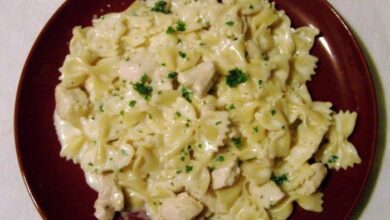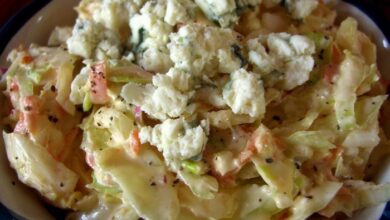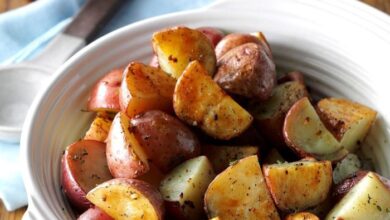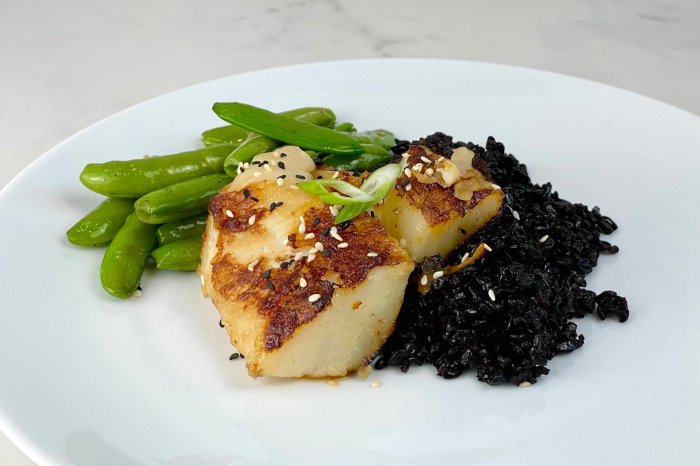
Japanese Miso Butter Scallops: A Flavorful Fusion
Japanese miso butter scallops take center stage, a culinary masterpiece that blends the rich umami of miso with the creamy indulgence of butter, all enhanced by the delicate sweetness of scallops. This dish is a testament to the artful balance of flavors that defines Japanese cuisine.
The origins of miso, a fermented soybean paste, trace back centuries, deeply embedded in Japanese culture and culinary traditions. Its savory depth, combined with the buttery richness and the tender sweetness of scallops, creates a harmonious symphony of taste that will leave you craving more.
From the moment you inhale the aroma of sizzling scallops infused with miso and butter, you’re transported to a world of culinary delight. The texture is equally captivating, with the scallops offering a delicate melt-in-your-mouth experience, while the miso butter sauce adds a touch of richness and complexity.
This dish is a perfect example of how simple ingredients can be transformed into a culinary masterpiece, showcasing the beauty of Japanese cuisine.
Cooking Techniques
The method you choose to cook your Japanese miso butter scallops will significantly impact the final texture, flavor, and overall presentation. Let’s explore the most popular methods and their respective advantages and disadvantages.
Pan-Searing
Pan-searing is the most common and arguably the simplest method for cooking scallops. It involves quickly cooking the scallops in a hot pan with a small amount of oil or butter. This method results in a beautifully browned exterior and a tender, juicy interior.
- Advantages:
- Quick and Easy:Pan-searing is a fast and efficient cooking method, perfect for weeknight dinners.
- Crispy Exterior:The high heat of the pan creates a delicious, crispy crust on the scallops.
- Flavorful:The miso butter sauce can be easily incorporated into the pan while searing, adding a rich and umami flavor to the scallops.
- Disadvantages:
- Overcooking Risk:Scallops cook quickly, so overcooking is a risk if you’re not careful.
- Limited Browning:You can only sear one side at a time, which might result in less browning overall.
Tip:To achieve the perfect sear, ensure the pan is very hot before adding the scallops. Use a high-heat oil like avocado oil or grapeseed oil. Avoid overcrowding the pan, as this will lower the temperature and prevent proper browning.
Grilling
Grilling offers a smoky flavor and attractive grill marks, making it an excellent choice for outdoor entertaining. It involves cooking the scallops over direct heat on a preheated grill.
Japanese miso butter scallops are a dish that’s both savory and sweet, with a depth of flavor that’s hard to resist. The miso paste adds a unique umami punch, while the butter creates a rich and creamy sauce. It’s a dish that’s perfect for a special occasion, but it’s also easy enough to make for a weeknight dinner.
If you’re looking for something a little sweeter to finish off your meal, try a slice of sour cream blueberry coffee cake – the tangy cream cheese frosting is a delicious complement to the savory scallops.
- Advantages:
- Smoky Flavor:Grilling imparts a distinct smoky flavor to the scallops.
- Even Cooking:Grilling can cook scallops evenly on both sides.
- Versatility:You can easily grill other ingredients alongside the scallops, such as vegetables or skewers.
- Disadvantages:
- Overcooking Risk:Similar to pan-searing, scallops can overcook quickly on the grill.
- Limited Sauce Incorporation:While you can brush the miso butter sauce on the scallops during grilling, it might not be as effective as incorporating it directly into the pan.
Tip:For grilling, preheat the grill to medium-high heat. Ensure the grill grates are clean and lightly oiled to prevent sticking. Use a grill brush to remove any food debris from the grates.
Baking
Baking is a gentler cooking method that can be used to cook scallops evenly and prevent overcooking. This method involves placing the scallops on a baking sheet and baking them in a preheated oven.
- Advantages:
- Gentle Cooking:Baking helps prevent overcooking, resulting in tender and juicy scallops.
- Easy Preparation:Baking requires minimal hands-on time, making it a convenient option for busy cooks.
- Versatile:You can bake scallops with other ingredients like vegetables or pasta.
- Disadvantages:
- Less Browning:Baking does not create a crispy exterior like pan-searing or grilling.
- Limited Flavor:It might be more challenging to achieve the same level of flavor as pan-searing or grilling.
Tip:For baking, preheat the oven to 400°F (200°C). Place the scallops on a baking sheet lined with parchment paper. Bake for 5-7 minutes, or until the scallops are cooked through.
Japanese miso butter scallops are a real crowd-pleaser, with their sweet and savory flavors and tender, juicy texture. For a brunch that’s equally delicious and easy to prepare, try this easy French toast casserole – it’s perfect for feeding a crowd and can be made ahead of time.
And once you’ve enjoyed your French toast, the miso butter scallops will be a perfect, light and flavorful complement.
Flavor Variations: Japanese Miso Butter Scallops
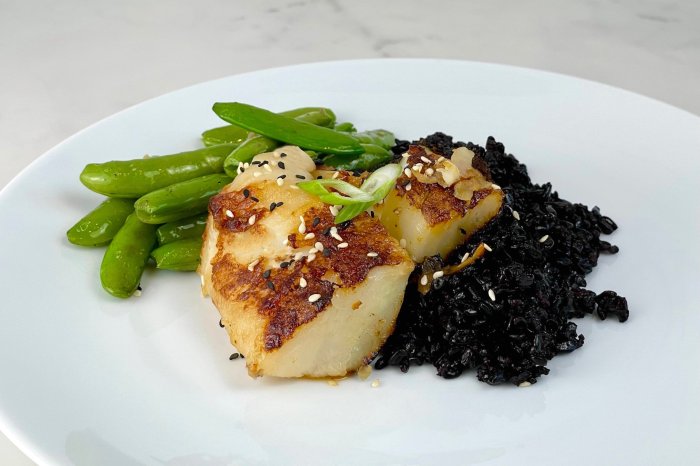
Miso butter scallops offer a delicious and versatile base recipe that can be easily customized to suit your taste preferences. By experimenting with different types of miso and incorporating additional ingredients, you can create a wide range of flavor profiles, from subtly sweet and savory to bold and spicy.
Types of Miso
Miso is a fermented soybean paste that comes in various types, each with its own unique flavor and color. The most common types used in cooking include:
- White Miso:This is the mildest and sweetest type of miso, with a light, almost creamy flavor. It is a good choice for beginners or those who prefer a more subtle miso flavor. It’s typically made with rice koji and has a light, pale color.
- Yellow Miso:This miso has a slightly stronger flavor than white miso, with a more pronounced umami taste. It is often used in traditional Japanese dishes and offers a balanced flavor profile. This miso is typically made with rice koji and has a yellow-brown color.
- Red Miso:This is the strongest and most flavorful type of miso, with a deep, rich flavor and a slightly salty taste. It is often used in miso soup and other hearty dishes. This miso is typically made with barley koji and has a dark red-brown color.
Additional Ingredients
Beyond the choice of miso, there are many other ingredients you can incorporate to enhance the flavor of your miso butter scallops. Here are a few suggestions:
- Garlic and Ginger:These aromatic ingredients add a savory and slightly spicy kick to the dish. Simply mince or grate them and add them to the pan with the scallops.
- Chili Flakes:For a touch of heat, add a pinch or two of chili flakes to the pan. Adjust the amount to your desired level of spiciness.
- Citrus Zest:A squeeze of lemon or lime zest adds a bright and refreshing flavor to the dish. It complements the umami of the miso and the sweetness of the butter.
- Fresh Herbs:Finely chopped herbs such as parsley, chives, or cilantro can add a burst of freshness and flavor to the dish. Add them at the end of cooking to preserve their flavor.
Flavor Variations Table
| Variation | Ingredients | Cooking Techniques | Serving Suggestions |
|---|---|---|---|
| Classic Miso Butter Scallops | White miso, butter, scallops | Sauté scallops in butter until cooked through, add miso paste, and stir until melted. | Serve with steamed rice, a side salad, or grilled vegetables. |
| Spicy Miso Butter Scallops | Yellow miso, butter, scallops, chili flakes | Sauté scallops in butter until cooked through, add miso paste and chili flakes, and stir until melted. | Serve with a dollop of sour cream or Greek yogurt for a cooling effect. |
| Garlic Ginger Miso Butter Scallops | Red miso, butter, scallops, garlic, ginger | Sauté garlic and ginger in butter until fragrant, add scallops, cook until cooked through, and stir in miso paste. | Serve with a side of stir-fried noodles or a bed of wilted spinach. |
| Citrus Miso Butter Scallops | White miso, butter, scallops, lemon zest | Sauté scallops in butter until cooked through, add miso paste and lemon zest, and stir until melted. | Serve with a drizzle of olive oil and a sprinkle of fresh parsley. |
Serving Suggestions
Japanese miso butter scallops are a versatile dish that can be enjoyed in a variety of ways. From simple and elegant to more elaborate presentations, there are many options for serving these savory and flavorful scallops.
Plating Options
Plating options play a significant role in enhancing the visual appeal and overall dining experience. Here are some plating suggestions that highlight the delicate flavors and textures of the scallops:
| Plating Option | Visual Appeal | Flavor Combinations | Description |
|---|---|---|---|
| Scallops on a bed of steamed rice | Simple and elegant, with the scallops as the centerpiece | Salty, savory, and umami flavors of the scallops complement the mild sweetness of the rice | Serve the scallops on a bed of fluffy white rice, garnished with a sprinkle of chopped scallions or a drizzle of sesame oil. The contrasting colors and textures create a visually appealing and satisfying dish. |
| Scallops served with a side of stir-fried vegetables | Vibrant and colorful, with a variety of textures | The sweet and savory flavors of the scallops are balanced by the fresh and crisp vegetables | Pair the scallops with a medley of stir-fried vegetables, such as broccoli, snap peas, and carrots. The bright colors and contrasting textures of the vegetables create a visually appealing and flavorful combination. |
| Scallops served with a side of noodles | Warm and inviting, with a comforting appeal | The creamy miso butter sauce complements the noodles, while the scallops add a luxurious touch | Serve the scallops over a bed of your favorite noodles, such as udon or ramen. The creamy miso butter sauce coats the noodles, creating a rich and flavorful dish. |
| Scallops served with a side of salad | Fresh and light, with a refreshing appeal | The salty and savory flavors of the scallops are balanced by the acidity of the salad | Pair the scallops with a simple salad of mixed greens, cherry tomatoes, and a light vinaigrette. The fresh and vibrant flavors of the salad complement the richness of the scallops. |
For a visually appealing and flavorful presentation, consider serving the scallops on a bed of steamed rice, with a side of stir-fried vegetables. The contrasting colors and textures create a visually appealing and satisfying dish, while the flavors of the scallops, rice, and vegetables complement each other perfectly.
Nutritional Information
Japanese miso butter scallops offer a delicious and nutritious meal. They are packed with protein, vitamins, and minerals, making them a healthy and satisfying choice.
Nutritional Value of Scallops
Scallops are a lean source of protein, providing about 20 grams of protein per 3-ounce serving. They are also a good source of essential vitamins and minerals, including vitamin B12, selenium, and zinc. These nutrients play important roles in various bodily functions, including energy production, immune system support, and cell growth.
Health Benefits of Miso
Miso, a fermented soybean paste, is a traditional Japanese ingredient known for its numerous health benefits. Miso is rich in probiotics, which are beneficial bacteria that support gut health. Probiotics contribute to a healthy digestive system, improve immune function, and may even help reduce inflammation.
Tips for a Healthier Dish, Japanese miso butter scallops
- Choose leaner cuts of scallops:
- Reduce the amount of butter:
Choosing leaner cuts of scallops, such as bay scallops, can help reduce the overall fat content of the dish. You can also reduce the amount of butter used in the recipe, opting for healthier alternatives like olive oil or cooking spray.

